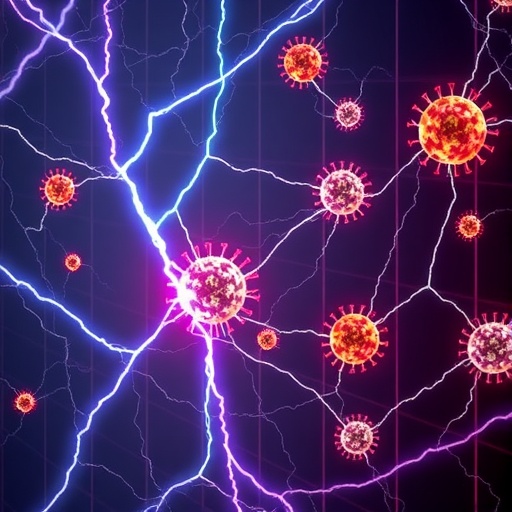In a groundbreaking study that illuminates the hidden role of bioelectricity in tissue health, researchers from King’s College London, collaborating with the Francis Crick Institute, have unveiled a sophisticated mechanism by which epithelial cells maintain tissue integrity. Their findings, recently published in Nature, detail how epithelial layers—those critical protective cell sheets lining every organ—utilize electrical signals to identify and extrude their weakest, most vulnerable cells. This discovery offers profound implications for understanding diseases like cancer and stroke, where disruptions in cellular energy may impair tissue maintenance and repair.
Epithelial tissues are remarkable for their rapid turnover, a dynamic balance of cell birth and death that preserves an unbroken protective barrier against the external environment. Central to this upkeep is the process of extrusion, where excess or damaged cells are expelled from the tissue surface. Previously, it was known that mechanical crowding triggers this extrusion, physically squeezing surplus cells until they detach and die. However, the new research goes further, demonstrating that this process is far from random. Instead, cells with deficient energy reserves—those least capable of sustaining normal function—are selectively targeted and eliminated through an intricate bioelectrical sensing mechanism.
At the heart of this system lies the electrical potential across cell membranes, a fundamental property extensively characterized in nerve and muscle cells but less understood in epithelial tissues. The researchers employed advanced live imaging techniques to capture a striking phenomenon: just before extrusion, affected epithelial cells emit a brief, lightning-like electrical flash. This bioelectric signal arises from a rapid influx of sodium ions into the cell, generating a transient current that reveals the cell’s compromised energetic state to its neighbors.
Further investigation revealed that specialized sodium channels become activated in response to cellular crowding. Energetically healthy cells can efficiently expel sodium ions to maintain their membrane potential, but energy-deficient cells lack this capability. Facing an energetic shortfall, these weakened cells marshal their remaining resources to trigger an electrical current that causes water to exit the cell, leading to cellular shrinkage. This dehydration acts as a physical cue that initiates the extrusion process, effectively removing compromised cells from the epithelial barrier.
The discovery underscores how epithelial tissues continually perform a form of quality control, using bioelectrical cues to discriminate between healthy and energy-poor cells. According to lead author Dr. Saranne Mitchell, this sodium channel functions as an energetic sensor, “exposing cells with the least amount of energy and targeting those cells for death.” This electrical surveillance ensures that tissues remain robust and functional, swiftly excising cells that might otherwise become dysfunctional or dangerous.
This bioelectrical extrusion system holds significant clinical interest, especially concerning metabolic imbalances that occur in chronic diseases. For example, the team speculates that in conditions of nutritional excess, where energy availability is high, this “low energy trigger” may be overridden. Such a scenario could allow defective cells to evade extrusion, accumulate, and contribute to malignancies like cancer. Conversely, in states of energy deprivation—such as the compromised blood flow seen in stroke—excessive extrusion induced by heightened energy stress could exacerbate tissue damage.
The implications of these findings extend beyond fundamental biology, suggesting new avenues for therapeutic intervention. Previous work by the scientists highlighted how modulation of epithelial extrusion pathways might aid in repairing airway barriers in respiratory diseases like asthma. Going forward, unraveling how bioelectric signaling intersects with metabolic pathways could provide innovative strategies to mitigate tissue degeneration and promote regeneration.
Epithelial cells expend considerable metabolic energy to maintain their membrane potentials, a fact often overshadowed by attention to electrically excitable cells such as neurons. This research brings to light the vital importance of such bioelectric phenomena in broader biological contexts. The rapid sodium influx triggering extrusion represents a final, desperate attempt by energy-poor cells to signal distress before being removed, a process akin to a “last gasp” that preserves overall tissue health.
By combining live-cell imaging, ion channel inhibition experiments, and electrical measurements, the team delineated a previously unappreciated link between cellular energetics and the mechanics of cell death. Ion channels, long studied for their functions in excitable tissues, emerge here as central players in epithelial homeostasis, translating metabolic state into physical cues for cell elimination.
The study contributes a critical piece to understanding the multifactorial nature of diseases involving epithelial dysfunction. Since the health of epithelial barriers is essential in preventing infection, inflammation, and tumorigenesis, recognizing how energy sensing influences extrusion could lead to biomarkers for early disease detection. Moreover, it opens questions about how lifestyle factors like diet and metabolic health influence tissue renewal processes at the cellular level.
Funded by a broad consortium including the Wellcome Trust, Cancer Research UK, and the Howard Hughes Medical Institute, this research exemplifies the power of interdisciplinary collaboration. The Francis Crick Institute, where the work was partly conducted, serves as a hub for such integrative efforts, combining expertise in biophysics, cell biology, and medicine to tackle complex biological problems.
As science continues to expose the subtle electrical underpinnings of cellular life, this discovery represents a paradigm shift in our understanding of tissue homeostasis. It reveals an elegant, bioelectric quality control system operating silently within us, tirelessly ensuring that only the fittest cells contribute to the protective barriers safeguarding our health.
Subject of Research: Cellular bioelectricity and epithelial cell extrusion mechanisms related to tissue health and disease.
Article Title: (Not explicitly provided in the content)
News Publication Date: (Not explicitly provided in the content)
Web References:
References:
- Mitchell, S. et al., Nature (2025). Study on bioelectric signaling in epithelial cell extrusion.
Image Credits: Credit King’s College London
Keywords: Life sciences, Biochemistry, Biophysics, Cell biology, Microbiology, Health and medicine, Cancer, Respiratory disorders, Metabolic disorders




